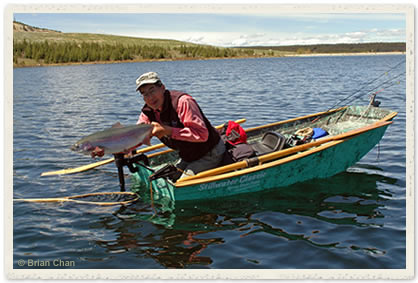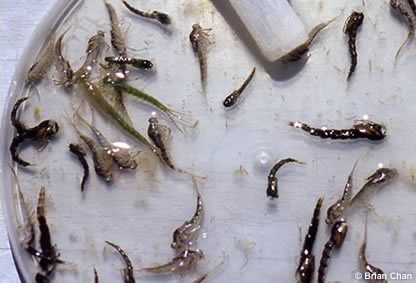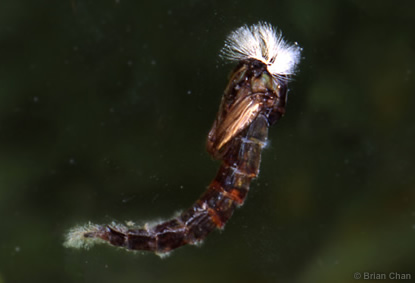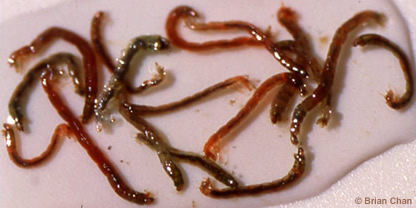Chironomid Tactics
April 24, 2006

To many North American fly fishers, chironomids are those very tiny patterns imitated on hook sizes #18 to #24 or smaller that are also found in lakes but are more common in rivers and especially productive tailwaters. However, the larval and pupal stages of many chironomid species found in the stillwaters of the western states and provinces are commonly represented on #16 to #10 shrimp/pupa hooks such as the Mustad Signature C49S or Tiemco 2457. The largest pupal patterns which are known locally as “bombers” are dressed on #12-3XL to #8-3XL hooks. Chironomid pupa are found in a wide variety of colours with the most common ones being black, maroon, green and brown and various shades of each colour. One of the keys to being successful is understanding and recognizing that there are various sizes and colours of the pupa and that the trout can be quite selective about both. The use of throat pumps (stomach pumps) can be very beneficial in determining what colour and size of larvae or pupae a particular trout may have just inhaled. The proper use of a throat pump samples the esophagus or throat of the fish, where the food items are still alive. The fish can then be released alive. However, improper use of the tool can damage or even kill a fish, so take care.
 Typical throat pump sample from stillwater trout. Sample shows a mix of various sized chironomid pupae, baetis and damsel nymphs.
Typical throat pump sample from stillwater trout. Sample shows a mix of various sized chironomid pupae, baetis and damsel nymphs.
There are numerous factors that produce the exceptional chironomid fishing found in these waters. Most significant is the basic water quality. These lakes are rich in key elements like calcium, magnesium, phosphorus and nitrogen, the building blocks for aquatic plant growth, phytoplankton, zooplankton and the many aquatic insects and other macro invertebrates that grow healthy fish. This water chemistry, in combination with long open water growing seasons, also provides ideal habitat for chironomids. There are so many species of chironomids that emergences begin occurring from almost the day the ice comes off a lake to well into the late summer or early fall period. Actual emergences are very heavy with literally thousands upon thousands of pupa ascending to the surface of the lake to emerge. Trout literally “breathe” in pupa because of the shear densities in the water column. Many of the chironomid species are relatively large so they can make up a significant proportion of the annual diet of a trout. And finally, trout eat so many of these insects during prime emergence periods that they will take these imitations even when there is no actual emergence or only very minor ones occurring such as during the very late fall period.
Another important factor that contributes to the productivity of many of these stillwaters is the fact that they are monocultures in that the only fish species present are the trout. There is no competition for food or habitat from other non-game fish.
The larval and pupal stages attract the most attention of the trout in these lakes with adults often receiving only passing interest which is quite a contrast to many stillwaters and rivers found in other parts of Canada and the United States. The difference could be that eating easily accessible pupa is far more energy efficient that having to chase down an evening meal of egg laying adults. Also, to avoid predators such as ospreys and loons it is often much safer for a fish to be feeding closer to the lake bottom than at or nearer the surface. This is especially true in lakes with very clear water.
Fly Fishing Tactics
The majority of the feeding interest by trout is in the pupal stage due in large part to the sheer numbers that can be present throughout the water column during an emergence. Historical diet studies done on numerous Kamloops area lakes have shown that a 3 pound trout could easily have over 1500 pupa in its stomach all of which would have been ingested during a morning or afternoon feeding period. Pupal emergences can occur in a wide depth range but the majority of larvae are living in water from 2 to 8 metres in depth which coincides with the extent of the littoral or shoal zone of a typical lake. The general rule of thumb is the earliest emergences of the season begin in shallow water and then gradually move out deeper as water and air temperature increase. Therefore by mid to late summer some of the best emergences will be in the deeper parts of the lake between 8 and 15 metres in depth. Chironomids do start emerging within days of the ice coming off a lake but the most intense emergences begin once the surface water temperature reaches between 10°C and 15°C. This tells us that water temperatures at the bottom of the lake have been warm enough to complete the transition from larval to pupal life stage. Actual daily emergences usually begin mid-morning, peak in the mid-afternoon and are waning by late afternoon. The most intense chironomid emergences occur from early April through the end of July, but much depends on lake latitude and elevation. Intense means heavy, multiple species emergences that literally leave wind rows of cast shucks on the water. Smaller and shorter duration emergences will continue through to at least the end of September on many water bodies.
 Chironomid pupa
Chironomid pupa
Chironomid larvae are also an important trout food source, especially those of larger species as they can easily reach almost an inch in length. In most feeding situations trout cruise along the lake bottom and literally suck out the larvae from their tubecases. It is quite common to do a throat pump of a trout and retrieve live larvae and remnants of their muddy cases. Larval densities can be very high and they make easy meals. There are also situations when larvae will be seen floating on the surface of the lake or suspended in the water column. These occurrences often coincide with the completion of spring or fall turnover. Turnover results in the complete mixing of the water column which creates currents that sweep across the lake bottom which can pull the larvae out of their tubes making them an even easier meal. Also, in the late fall, larvae that will be over-wintering in the lake will often move from shallow water to deeper water and re-establish their tube cases. This migration ensures that the larvae develop under ideal conditions during the winter months. Migrating larvae can also get swept up into the water column by wind action moving across the littoral or shoal areas of the lake. Trout are often moving back onto the shoal or shallow water areas during the same time frame as they are looking for as much food as possible in advance of a long winter.
 Chironomid larvae
Chironomid larvae
The most effective way to fish these lakes is from a boat, pontoon boat, float tube or some other floating craft. Most lakes have very soft muddy or marl bottoms making it difficult to wade out and reach the depths that chironomids are emerging. Boat anglers typically use two anchors to ensure the craft does not move, particularly when the wind is constantly changing direction. Anchoring your boat at both bow and stern is the best way to minimize movement. The ultimate goal is to have as much control as possible over your retrieves so that even the most subtle takes can be detected. Equally important is knowing the depth you are anchored in so that larval and pupal patterns can be fished as close to the bottom as possible or at precise depth zones higher in the water column. Marking anchor ropes at one metre intervals with a water proof felt pen is a simple way to get a good estimate of depth. A portable fish finder is even better.
Floating Line and Long Leader Technique
A variety of fly lines can be used to effectively fish larval, pupal and adult patterns but the floating line is the most versatile and often the most effective. This is because the majority of pupal emergences occur in water less than about 8 metres. A floating line and long leader without a strike indicator allows effective coverage of the entire water column at these depth ranges. As mentioned earlier, rainbows prefer to feed on the larvae and pupae closer to the bottom than near the surface of the lake. We want to present imitations of both larvae and pupae as close to lake bottom as possible. The traditional approach is to use the floating line and a tapered leader that is at least 25% longer than the depth zone being fished. A weighted or un-weighted pattern is cast out and allowed to sink to within about a foot of the bottom. A very slow (watching paint dry slow!) hand twist retrieve or strip retrieve is then used to move the larval or pupal pattern horizontally through the water while the fly stays in the desired depth zone. This technique is extremely effective but it requires considerable patience to wait for the fly to sink and then to maintain the slow retrieve. Just keep in mind that the real pupa are moving very slowly up through the water column but the goal here is to keep the fly in the depth zone that the trout are actually feeding. Strikes are often very soft as the trout are just inhaling pupa after pupa while lazily swimming along or near the lake bottom. This same setup can be used to wind drift your fly from the anchored position. With a gentle breeze at your back, cast out to either side, and allow the floating line and fly to be pushed downwind. The undulating motion caused by the wave action imparts a natural up and down action to the fly.
Floating Lines and Strike Indicators
Floating lines and strike indicators are a deadly combination for fishing larval and especially pupal patterns. Indicators allow a pattern to be suspended at a very precise depth. Hard shelled indicators such as those made by Thill or Frog Hair are durable, easy to cast and very visible. The rule of thumb for fishing indicators is to set the depth of the fly about 30 cm off the lake bottom and gradually move higher by 3 to 5 cm intervals if there is no luck at the deeper levels. Sometimes the trout will only want the pupa if it is sitting almost perfectly still and other times a slight bobbing action of the fly is enough to trigger a strike. A slight riffle or chop on the water often provides the perfect amount of action to a pattern suspended under an indicator. Movement can be further enhanced by wind drifting with the indicator setup. Indicators are ideal to use when fishing depths of between 5 and 15 feet. They can be used effectively in deeper water such as 20 to 25 feet but in these cases a quick release indicator will make it a lot easier to land a fish. There will be days when the trout will pull the indicator quickly under and other days when all one sees is a slight quiver of the indicator therefore it pays to be watching it very closely at all times.
Sinking Line Technique
The chironomid pupal ascent can also be fished effectively with sinking lines. Slow or intermediate sinking lines and particularly the clear intermediate lines, can be used in place of the floating line and long leader nymphing technique if fishing water in the 5 to 8 metre range. Use the count down method to determine where your fly is in relationship to the lake bottom. Ideally, we want the pupal pattern to sink down to the bottom before initiating a continuous slow hand twist or strip retrieve bringing the fly right to the surface of the lake. This sinking line technique presents the pupal pattern through the entire depth zone that the fish may be feeding in. Often the strikes will occur just as the fly is still within a metre of the bottom or when the fly is within a couple of metres of the surface. Hitting fish high in the water column tells us the trout are following the pupal pattern up from the lake bottom and then grabbing the fly just before it gets too close to the surface of the lake.
Deep water chironomid emergences occur at depths of over 8 metres and upwards of 15 metres. These emergences generally take place during the mid to late summer period. Fast sinking fly lines are very effective in imitating the pupal ascent from these depths. Take a type 3 to type 7 full sinking or density compensated sinking line and cast out the same depth anchored in. Allow the fly line and pupal pattern to sink until straight up and down. Begin a slow but continuous hand twist retrieve bringing the fly right up to the surface of the lake just like the real pupa. As with the intermediate sinking line technique, the strikes generally occur within a couple of metres of the bottom or within 2 metres of the surface of the lake. The takes are almost always very hard which makes this an exciting way to fish. A 3 metre long leader is ample for this particular technique.
Fly Pattern Selection
There are some basic colour and ribbing combinations that cover the major chironomid pupae found in these lakes. Pupal bodies with ribbings of copper, red copper, green copper, silver and gold wire or holographic tinsels in the same colours are always reliable. The most common pupal body colours are black, maroon, brown and shades of green. Excellent body materials to consider are stretch flex, stretch floss, Flashabou, Crystal Flash and traditional flosses. Pupal gills or breathing filaments can be imitated well with white metal or pearlescent plastic beads or with white antron or ostrich herl if tying patterns with traditional shellbacks. Black, silver and copper metal or tungsten beaded pupal patterns are also quite popular. The gills are represented by tying in antron so that the fibres protrude forward and then the bead is placed over the antron. If there were one “go to” pupal pattern for these western North America lakes lakes it would be a black stretch flex or stretch floss body with a red copper wire rib and white metal bead head tied on a Mustad Signature C49S or Tiemco 2457 in sizes #14 to #10. Refinements to pattern selection should take place on the water where larvae and pupae can be closely observed and colour and size can be matched on the spot.
Chironomid larval and pupal patterns, like many other flies, fish better when tied to the tippet using a loop knot such as the Duncan Loop Knot or the Non-slip Loop Knot. This style of knot allows the fly to move much more naturally whether being retrieved or suspended under a strike indicator.
Equipment Selection
Rods in 3 to 3.5 metre lengths matched to 5 or 6 weight lines are perfect for these waters and the fish size that will be encountered. Longer rods do provide an extended reach which makes them better suited to fishing strike indicators. Tippet spools of 3X to 5X should be carried in your tackle bag along with some 12 to 15 foot long tapered leaders that end in 3X and 4X. Flourocarbon tippet material can substantially improve results when fishing the very clear lakes. Reels should carry at least 75 metres of backing behind weight forward floating, intermediate sinking and fast or extra fast sinking lines. Soft, lead-free puddy or split shot can always be added to the leader in order to get the fly faster to fish holding zones.
Note:
Life Cycle: Chironomids undergo a complete life cycle that includes egg, larva, pupa and adult phases. Adult females return to the lake in the evening or early morning hours to initiate the next generation. They fly and skim over the water and release eggs as the tip of their abdomen penetrates the surface film. The eggs sink to the lake bottom and hatch into the larval stage... read the full text »
Further Reading: You can read more detail on fishing shrimp in Brian's book 'Morris & Chan on Fly Fishing Trout Lakes'.
Hi Brian,
could you tell me where to get a throat pump. I have seen you use them on a few tv shows but I can’t seem to find a place to buy them in BC.
Hi Clayton,
Can I ask what area you’re based in (assuming you’re looking to get one from a fly shop rather than online)?
O.K. Clayton, In response to your email. Chris Martinson at Bow River Troutfitters says they have a couple in stock. They deal online or you can order by phone. Gord at Kootenay Fly Shop stocks them so you could give them a call. I got mine from either Kaufmann’s in Seattle or Bow River Troutfitters in Calgary… Can’t quite remember. You could try Kamloops Fly Shop though personally I didn’t find them very good online communicators – very friendly when you’re in their shop…
Brian….Love your work and videos. Am a big fan of suspending Chirono’s under an indicator and have landed my largest fish ever on some of my local lakes here in Central Oregon! Keep up the great work…maybe we’ll see you some day here!
HI Troutbum,
just catching up on my replies. I had a very busy spring and early summer fishing the local lakes. I can’t say enough about how productive it is to suspend not only chironomids but other prominent trout food sources under indicators. I love hanging leeches, mature and immature damselfly nymphs and either doing a very slow, intermittent retrieve or wind drifting back to the boat.
Hard for fish to resist them when the fly stays in the depth zone the fish are feeding
Hey Brian I have been fishing some of high mountain lakes that have brook trout and cutthroat trout in them. My question is: why or how can I catch the brook trout on a chrono? I have caught many cutthroat and rainbows on my chrono’s , but only can get the brook trout to hook up with a woolybugger or something moving at a higher speed. I tie my own flies and any fly recommendation for fishing and catching these brookies with chrono’s would be great.
HI Kash,
I love fishing for Brook Trout. I do find them to be very finnicky eaters, by that I mean they tend to feed for much shorter periods of time than rainbows or cutthroat and they can be very selective on what they will eat. My best success with chironomids on brookies is when there is a very heavy emergence or really big pupa coming up through the water column. By big I mean pupal patterns that are over 15 mm in length. Even then, the brookies will bite heavy for an hour o so then quit even though the emergence is still strong. When this happens I will often switch to a Deep 7 line and strip Boobies through the water. That seems to get the attention of at least a few aggressive brook trout.
That is what makes brookie fishing so much fun, totally unpredictable but very rewarding when we figure them out,
cheers,
Brian
Hi Brian–love your shows and realy appreceate your articals have learnd a ton and still love to read on. I tie my flys and have had minimal sucsess, but stay hard at it keep up the great work and I look forward to more articals.
Thanx –Don
Hello Brian,
I’ve recently seen your cable fly fishing TV show (chironomid pattern) and gone online to get information on chironmid flies. I’m from California (Bay Area), I fish 2 lakes in California, Lake Davis & Frenchman. I saw in one of your YouTube videos about shrimp patterns in the BC lakes. Do you happen to know if there are shrimps in these 2 lakes and are shrimps in most Western State lakes?
Your shows and information are great thanks so much…
Sterling
Both Davis and Frenchman have small populations of scuds which the fish may feed on when they move into the shallows. if Brian doesn’t get back to you, speak to local guide Don Rotsma 530-832-4047
Hello Brian,
Do you have any suggestions on how to fish a deep southeastern reservior (Dale Hollow)where the main forage seems to threadfin shad and Alewives. Bottom make up is mostly pea gravel, shale, chunk with some grass beds but in 20-60 ft of water. Most of the trout caught with regularity are taken trolling over 20ft -120ft of water. My initial thoughts are a long leader, slip float and clouser or bugger patterns.
Any direction you can point me in would be greatly appreciated.
Thank you- Travis